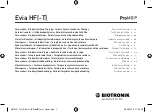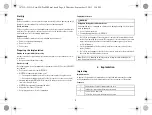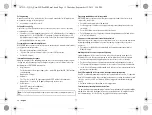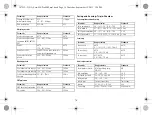
10
Keeping distance between leads
Auto-initialization
Auto-initialization begins automatically once the first connected lead is sensed.
Auto-initialization is terminated 10 minutes after connection of the first lead. If no other
program has been transferred in the meantime, the device subsequently works with
active automatic functions in the standard program.
Manual setting of the lead polarity or measurement of lead impedances is not neces-
sary.
Behavior during auto-initialization
• During reprogramming:
Auto-initialization is canceled and the transferred program is immediately active.
• During testing:
Auto-initialization will be continued upon completion of the test.
• During transmission of a permanent program:
Auto-initialization is terminated and the transferred program is active.
Precautionary Measures while Programming
Checking the device system
• After auto-initialization, perform a follow-up to see if the device system is func-
tioning properly.
• Perform a pacing threshold test to determine the pacing threshold.
Performing standard tests and monitoring the patient
Critical conditions can occur for the patient even during standard tests due to inade-
quate parameter settings or interrupted telemetry.
• Ensure sufficient patient care even during tests.
• After the threshold test, check to determine whether the threshold is clinically and
technically justifiable.
• Continuously monitor the ECG and the patient's condition.
• Cancel testing if necessary.
Cancelling telemetry
Programmer interference or interrupted telemetry during performance of temporary
programs (follow-up tests) can result in inadequate pacing of the patient. This is the
case if the programmer can no longer be operated due to a program error or
a defective touch screen and therefore the temporary program cannot be terminated.
Under these circumstances, it is helpful to cancel telemetry, in which case the device
automatically switches to the permanent program.
• In the case of telemetry with PGH: lift the programming head by at least 30 cm.
• Turn off possible sources of interference.
Avoiding critical parameter settings
No modes and parameter combinations that pose a risk to the patient should be set.
• Prior to setting rate adaptation, determine the patient's capacity for strain.
• Check compatibility and effectiveness of parameter combinations after making
settings.
Manually setting lead polarity
Due to the risk of an entrance/exit block, bipolar lead polarity (sensing/pacing) should
only be set if bipolar leads are implanted.
Recognizing lead failure
Automatic impedance measurement is always switched on.
• Impedance values that indicate technical failure of a lead are documented in the
event list.
Setting triggered mode
Triggered modes perform pacing regardless of intrinsic cardiac events. To prevent
undersensing due to electromagnetic interference in special cases, a triggered mode
can be displayed.
W
WARNING
Inadequate therapy
When leads are not spaced sufficiently apart or are positioned inappropriately, this
can lead to far-field sensing or insufficient defibrillation.
• Tip and ring electrodes must not have contact with each other.
Note:
After auto-initialization, all parameters are activated as in the standard
program with the following exceptions:
• DDD
• The automatically determined lead configuration (unipolar or bipolar) is set.
387513--D_GA_Evia-HF-ProMRI_mul.book Page 10 Thursday, September 12, 2013 3:34 PM












































